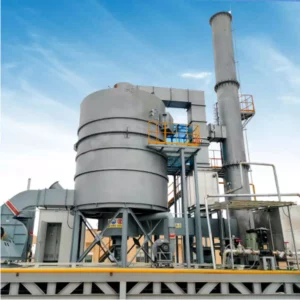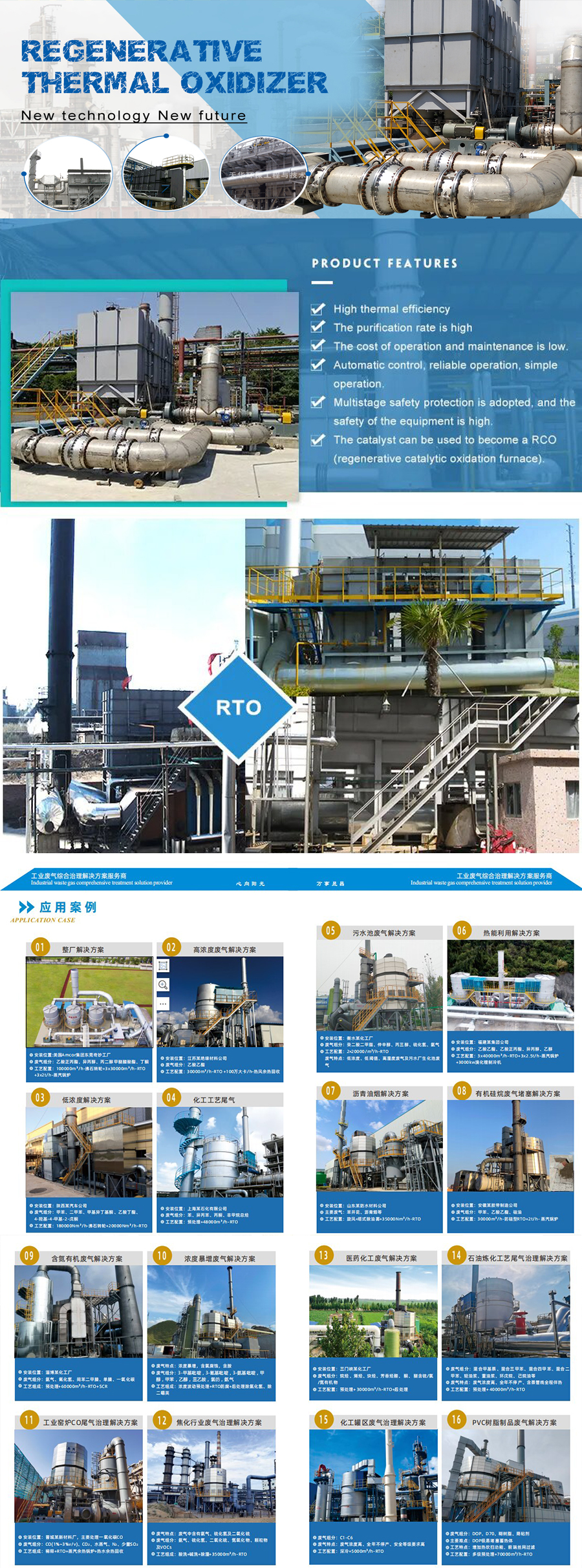Základní informace.
Model NO.
RTO
Typ
Nástroj pro monitorování životního prostředí
Hlavní funkce
Odstraňování odpadních plynů
Aplikace
Chemický průmysl
Značka
Raidsant
Čistá účinnost
99.8%
Stav
Nový
Ochranná známka
Raidsant
Přepravní balíček
Film zabalený
Původ
Zhejiang Čína
Popis produktu
HangZhou Raidsant Machinery Co.;,; Ltd.; se specializuje na vývoj a výrobu inovativních práškových chladicích peletizačních strojů a souvisejících průmyslových strojů na zpracování odpadních plynů.; S téměř 20letou historií výroby; máme dobrý trh ve více než 20 provinciích v Číně; a některé z našich výrobků byly vyváženy do Saúdské Arábie, Singapuru, Mexika,; Brazílie,;Španělsko,; Amerika,; Rusko a Korea; atd.;
Specifikace:;
* Kompaktnější než stávající zařízení
* Nízké provozní náklady
* Dlouhá životnost zařízení
* Žádné změny tlaku
Účel:;
Energeticky úsporný systém, který spaluje těkavé organické sloučeniny (VOC); a odpadní plyn využitím tepla; a shromažďuje přes 99.;8 % odpadního tepla výfukových plynů pomocí keramických regeneračních materiálů (katalyzátor); s velkým povrchem a nízkou tlakovou ztrátou.;
Aplikace:;
1.; Proces sušení malby
2.; proces tisku kovů
3.; proces sušení vláken
4.; proces lepicí pásky
5.; proces zpracování odpadu
6.; proces výroby polovodičů
7.; kouř,; cukrářský a pečicí proces
8.; petrochemický proces;
9.; proces výroby léků a potravin;
10.; jiný proces generování VOC
Zásluhy:;
* Kompaktnější než stávající zařízení
* Žádné změny tlaku
* Vysoká míra rekuperace tepla (přes 95 %);
* Perfektní VOC úprava (přes 99.;8%);
* Dlouhá životnost zařízení
* Nízké provozní náklady
* Lze vyrobit v kruhu nebo čtyřúhelníku
Obecné popisy a vlastnosti:;
1.; Princip fungování
Provozní metoda, která neustále mění výboje otáčením rotačního ventilu
2.; Změna procesního tlaku
Žádná změna tlaku, protože směr větru se mění v pořadí rotací rotačního ventilu
3.; Investiční náklady
Přibližně 70 % typu postelí
4.; Instalační prostor
Jedná se o jednu nádobu, takže je kompaktní a vyžaduje méně instalačního prostoru.;
5.; Údržba
Je snadné jej udržovat, protože rotační ventil je jedinou pohyblivou částí.;
Těsnicí část rotačního ventilu je zřídka opotřebovaná, protože se otáčí nízkou rychlostí.;
6.; Stabilita
Žádná rizika v procesu, protože je vždy otevřen, i když má rotační ventil problémy.;
7.; Účinnost léčby
Účinnost ošetření zůstává zachována, protože těsnicí část je zřídka opotřebována, i když je provozována po dlouhou dobu.;
Adresa: No.3, Zhenxin Middle Road, Zóna ekonomického rozvoje, HangZhou, ZheJiang
Typ podnikání: Výrobce/Továrna, Obchodní společnost
Rozsah podnikání: chemikálie, elektrika a elektronika, výrobní a zpracovatelské stroje, bezpečnost a ochrana
Certifikace systému managementu: ISO 9001
Hlavní produkty: peletizátor, vločkovač, pastilátor, granulátor, chemický peletizátor, voc
Představení společnosti: HangZhou Raidsant Machinery Co., Ltd., dříve nazývaná HangZhou Xinte Plastic Machinery Factory, se specializuje na výrobu inovativních strojů na recyklaci plastů. S téměř 20letými zkušenostmi máme dobrý trh ve 20 provinciích v Číně a některé naše výrobky byly exportovány do Indonésie, Ruska a Vietnamu atd. Mezi naše hlavní produkty patří DZ Type Pastillator, linka na recyklaci odpadních pneumatik, Big Caliber Plastic Linka na recyklaci drtičů trubek, kontinuální žíhací stroj na pocínování, QX typ PET, linka na mytí PE a trupu, drtič recyklace plastů SDP s dvojitou kolejnicí, výroba granulí pro řezání za tepla SJ jednotka, produktová řada PVC trubice (cinquefoil), produktová řada PVC Odd-tvarovaný materiál pro dveře a okna, produktová řada granulí ve vodě a Shredder pro plasty a recyklaci. Získali jsme 5 technických patentů.
Naše společnost klade důraz na technickou rekonstrukci, dováží pokročilé technologie z domova i ze zahraničí a neustále vyvíjí nové produkty. Naše zásada je náročná na vysokou kvalitu a nabízíme ty nejlepší produkty. Snažíme se realizovat náš slogan. Spokojenost našich zákazníků je naší věčnou snahou.
Hledáme zahraniční zákazníky nebo agenty. Pokud vás náš návrh zaujal, dejte nám prosím vědět, který z našich produktů vás nebo vaše zákazníky nejvíce osloví. Byli bychom vám velmi vděční, kdybyste nám poskytli nějaké představy o perspektivách trhu pro naše produkty. Doufáme, že se od vás brzy dozvíme příznivé informace! Naším cílem je, abychom si s vámi mohli vybudovat dobrý vztah nyní nebo v blízké budoucnosti. V případě jakýchkoli dotazů nebo požadavků nás prosím neváhejte kontaktovat.
Upřímně vás také vítáme v naší společnosti, abyste s námi diskutovali o podnikání a vyjednávali. Pro další rozšiřování našeho trhu a zákazníků naše společnost vítá zákazníky z domova i ze zahraničí v gestu nové značky na základě zcela nové koncepce řízení – kvalita, čest, služby. Hledáme systém řízení jakosti ISO 90001, abychom splnili požadavky našich zákazníků!

Can regenerative thermal oxidizers handle variable pollutant concentrations?
Regenerative thermal oxidizers (RTOs) are designed to handle variable pollutant concentrations effectively. They are capable of accommodating fluctuations in pollutant concentrations without significant adverse effects on their performance or efficiency. The ability of RTOs to handle variable pollutant concentrations is one of the advantages that make them suitable for a wide range of industrial applications.
Here are some key points to consider regarding the capability of RTOs to handle variable pollutant concentrations:
- High Destruction Efficiency: RTOs are known for their high destruction efficiency, which refers to their ability to effectively destroy or oxidize the pollutants present in the exhaust gases. The combustion chamber within the RTO is designed to maintain a sufficiently high temperature to ensure complete oxidation of the pollutants, regardless of their concentration.
- Retention Time: RTOs are designed with a sufficient residence or retention time within the combustion chamber. This allows the exhaust gases to spend enough time in the high-temperature zone, ensuring that even pollutants with varying concentrations are adequately treated and oxidized.
- Rekuperace tepla: The heat recovery system in an RTO, typically using ceramic media beds or heat exchangers, plays a crucial role in handling variable pollutant concentrations. The heat recovery system helps maintain the required temperature and provides thermal energy to sustain the combustion process, even during periods of low pollutant concentrations.
- Dynamic Operation: RTOs are designed to operate dynamically, meaning they can adjust their operating parameters to accommodate changes in pollutant concentrations. They can modulate variables such as the flow rates of the exhaust gases and incoming untreated gases, the temperature setpoints, and the switching frequency of the beds to optimize performance under varying pollutant loads.
- Monitoring and Controls: RTOs are equipped with advanced monitoring and control systems that continuously monitor pollutant concentrations, temperature, and other relevant parameters. These systems enable real-time adjustments and optimization of the RTO operation to ensure effective treatment of variable pollutant concentrations.
While RTOs can handle variable pollutant concentrations, it’s important to note that extreme or highly fluctuating pollutant concentrations may require additional considerations. In some cases, pre-treatment methods such as dilution or conditioning of the exhaust gases may be employed to ensure optimal performance of the RTO.
Overall, RTOs are versatile and reliable systems that can effectively handle variable pollutant concentrations, providing efficient and consistent treatment of industrial emissions.

How do regenerative thermal oxidizers handle particulate matter buildup in the system?
Regenerative thermal oxidizers (RTOs) employ various mechanisms to handle particulate matter buildup in the system. Particulate matter, such as dust, soot, or other solid particles, can accumulate over time and potentially affect the performance and efficiency of the RTO. Here are some ways RTOs handle particulate matter buildup:
- Pre-filtration: RTOs can incorporate pre-filtration systems, such as cyclones or bag filters, to remove larger particulate matter before it enters the oxidizer. These pre-filters capture and collect the particles, preventing them from entering the RTO and reducing the potential for buildup.
- Self-Cleaning Effect: RTOs are designed to have a self-cleaning effect on the heat exchange media. During the operation of the RTO, the flow of hot exhaust gases through the media can cause the particles to burn or disintegrate, minimizing their accumulation. The high temperatures and turbulent flow help maintain clean surfaces on the media, reducing the risk of significant particulate buildup.
- Purge Cycle: RTOs typically incorporate purge cycles as part of their operation. These cycles involve introducing a small flow of clean air or gas into the system to purge any residual particulate matter. The purge air helps dislodge or burn off any particles adhering to the media, ensuring their continuous cleaning.
- Periodic Maintenance: Regular maintenance is essential to prevent excessive particulate matter buildup in the RTO. Maintenance activities may include inspecting and cleaning the heat exchange media, checking and replacing any worn-out gaskets or seals, and monitoring the system for any signs of particulate accumulation. Regular maintenance helps ensure optimal performance and minimizes the risk of operational issues associated with particulate matter buildup.
- Monitoring and Alarms: RTOs are equipped with monitoring systems that track various parameters such as pressure differentials, temperatures, and flow rates. These systems can detect any abnormal conditions or excessive pressure drops that may indicate particulate matter buildup. Alarms and alerts can be triggered to notify operators, prompting them to take appropriate action, such as initiating maintenance or cleaning procedures.
It is important to note that the specific strategies employed to handle particulate matter buildup may vary depending on the design and configuration of the RTO, as well as the characteristics of the particulate matter being treated. RTO manufacturers and operators should consider these factors and implement appropriate measures to ensure the effective management of particulate matter in the system.
By incorporating pre-filtration, utilizing the self-cleaning effect, implementing purge cycles, conducting regular maintenance, and employing monitoring systems, RTOs can effectively handle and mitigate particulate matter buildup, maintaining their performance and efficiency over time.

What industries commonly use regenerative thermal oxidizers?
Regenerative thermal oxidizers (RTOs) are widely used in various industries that generate volatile organic compounds (VOCs), hazardous air pollutants (HAPs), and other harmful emissions. Some of the industries that commonly use RTOs for air pollution control include:
- Chemical Manufacturing: RTOs are extensively employed in chemical manufacturing processes that produce solvents, paints, coatings, adhesives, and other chemical products. These industries often generate significant amounts of VOCs that require effective control and abatement.
- Printing and Packaging: The printing and packaging industry utilizes RTOs to control the emissions of VOCs and HAPs from ink drying, coating, and solvent-based processes. RTOs ensure compliance with environmental regulations while maintaining high-quality printing standards.
- Pharmaceuticals: Pharmaceutical manufacturing processes often involve the use of solvents and organic compounds, leading to the generation of VOCs. RTOs provide an effective solution for capturing and destroying these emissions, ensuring a safe and environmentally friendly production environment.
- Paint and Coatings: RTOs are commonly employed in paint and coatings manufacturing facilities to control VOC emissions during the curing and drying processes. By effectively destroying VOCs, RTOs help reduce the environmental impact of these industries while maintaining product quality.
- Furniture and Woodworking: The furniture and woodworking industry utilizes RTOs to control emissions from processes such as painting, staining, and varnishing. RTOs help remove VOCs and HAPs generated during these operations, promoting a healthier working environment and reducing the impact on surrounding communities.
- Food Processing: Certain food processing operations generate VOCs and odorous compounds. RTOs are used in these industries to capture and treat emissions from cooking, baking, frying, and other food-related processes. RTOs ensure compliance with air quality standards while minimizing the impact on food quality and safety.
- Chemical Storage and Handling: Facilities involved in the storage and handling of chemicals, such as bulk liquid terminals and chemical distribution centers, may utilize RTOs to control emissions from venting and vapor recovery systems. RTOs help mitigate the release of VOCs and HAPs during various storage and transfer operations.
These are just a few examples, and RTOs can be found in many other industries that generate VOCs and HAPs. RTOs provide a versatile and effective solution for air pollution control, ensuring compliance with environmental regulations and promoting sustainable industrial practices.

editor by Dream 2024-05-15
